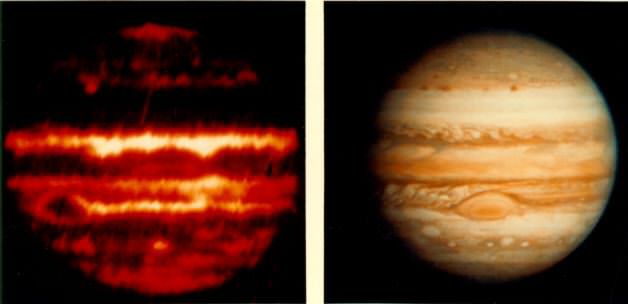[/caption]
Given how far Jupiter is from the Sun, you might think that “how cold is Jupiter?” would be a more relevant question and you would be partially right. “How hot is Jupiter?” becomes more relevant the deeper into the planet’s atmosphere and core that you travel. Near the very center of the planet, scientists believe that temperatures can reach 35,500 C.
The outer edges of Jupiter’s atmosphere are much cooler than the core region. Temperatures in the atmosphere are thought to be as cold as -145 degrees C. The intense atmospheric pressure on Jupiter contributes to temperature increases as you descend. Not far into the atmosphere the pressure can be ten times what it is here on Earth and scientists speculate that the temperature is 20 degrees C(average room temperature on Earth). A few hundred km deeper into the planet and hydrogen becomes hot enough to turn into a liquid. The temperature at this point is believed to be over 9,700 C. The layer of dense molten hydrogen metal extends to the 78th percentile of the planet’s radius. Between the cold clouds and the molten lower regions is an interior atmosphere of hydrogen. The hydrogen in this region is at a temperature where there are no distinct liquid and gas phases, so the hydrogen is said to be in a supercritical fluid state.
The molten inner regions of the planet serve to heat the rest of the planet through convection, so Jupiter gives off more heat than it receives from the Sun. This heating prevents it from being an ice giant instead of a gas giant, but wreaks havoc in the atmosphere. Storms and high winds are generated by cool air and warm air mixing here on Earth. Scientist think that the same holds true on Jupiter. The Galileo spacecraft observed winds in excess of 600 kph. One difference is that the jet streams that drive storms and winds on Earth are caused by the Sun heating the atmosphere. On Jupiter it seems that the jet streams are driven by the planets’ own heat. Storms on Jupiter are as out-sized as the planet. The Great Red Spot is a single storm that has been raging for hundreds of years. Other storms have been observed to grow to more than 2,000 km in diameter in a single day.
“How hot is Jupiter?” is more relevant than you may have thought. The planet’s inner heat seems to be the basis for its identity as a stormy world. The actual temperatures of the different areas of the planet may not be a mystery much longer. Hopefully, the recently launched JUNO space mission will clear up many of the Jovian theories that scientists currently have.
We’ve written many articles about the temperature of planets for Universe Today. Here’s an article about how hot Mercury is, and here’s an article about how hot Venus is.
If you’d like more information on Jupiter, check out Hubblesite’s News Releases about Jupiter, and here’s a link to NASA’s Solar System Exploration Guide to Jupiter.
We’ve also recorded an episode of Astronomy Cast just about Jupiter. Listen here, Episode 56: Jupiter.
Sources:
http://solarsystem.nasa.gov/planets/profile.cfm?Object=Jupiter
http://www.nasa.gov/mission_pages/juno/main/index.html

